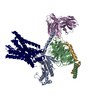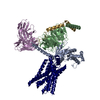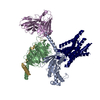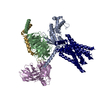[English] 日本語
 Yorodumi
Yorodumi- PDB-8xoh: Cryo-EM structure of GPR30-Gq complex structure in the presence of E2 -
+ Open data
Open data
- Basic information
Basic information
| Entry | Database: PDB / ID: 8xoh | ||||||||||||||||||||||||||||||||||||||||||||||||||||||
|---|---|---|---|---|---|---|---|---|---|---|---|---|---|---|---|---|---|---|---|---|---|---|---|---|---|---|---|---|---|---|---|---|---|---|---|---|---|---|---|---|---|---|---|---|---|---|---|---|---|---|---|---|---|---|---|
| Title | Cryo-EM structure of GPR30-Gq complex structure in the presence of E2 | ||||||||||||||||||||||||||||||||||||||||||||||||||||||
 Components Components |
| ||||||||||||||||||||||||||||||||||||||||||||||||||||||
 Keywords Keywords | MEMBRANE PROTEIN/IMMUNE SYSTEM / GPCR / estrogen / GPR30 / Gq / MEMBRANE PROTEIN / MEMBRANE PROTEIN-IMMUNE SYSTEM complex | ||||||||||||||||||||||||||||||||||||||||||||||||||||||
| Function / homology |  Function and homology information Function and homology informationnegative regulation of leukocyte activation / nuclear fragmentation involved in apoptotic nuclear change / G protein-coupled estrogen receptor activity / positive regulation of cardiac vascular smooth muscle cell differentiation / negative regulation of cell cycle process / keratin filament / apoptotic chromosome condensation / positive regulation of inositol trisphosphate biosynthetic process / positive regulation of uterine smooth muscle contraction / negative regulation of lipid biosynthetic process ...negative regulation of leukocyte activation / nuclear fragmentation involved in apoptotic nuclear change / G protein-coupled estrogen receptor activity / positive regulation of cardiac vascular smooth muscle cell differentiation / negative regulation of cell cycle process / keratin filament / apoptotic chromosome condensation / positive regulation of inositol trisphosphate biosynthetic process / positive regulation of uterine smooth muscle contraction / negative regulation of lipid biosynthetic process / steroid hormone binding / cellular response to mineralocorticoid stimulus / positive regulation of G protein-coupled receptor signaling pathway / dendritic spine membrane / positive regulation of extrinsic apoptotic signaling pathway / positive regulation of neurogenesis / presynaptic active zone / cellular response to peptide hormone stimulus / positive regulation of epidermal growth factor receptor signaling pathway / positive regulation of neurotransmitter secretion / nuclear estrogen receptor activity / dendritic spine head / steroid hormone receptor signaling pathway / negative regulation of fat cell differentiation / positive regulation of release of cytochrome c from mitochondria / negative regulation of vascular associated smooth muscle cell proliferation / positive regulation of endothelial cell apoptotic process / regulation of cytosolic calcium ion concentration / nuclear receptor-mediated steroid hormone signaling pathway / neuronal action potential / steroid binding / axon terminus / negative regulation of phosphatidylinositol 3-kinase/protein kinase B signal transduction / cytoplasmic vesicle membrane / positive regulation of release of sequestered calcium ion into cytosol / hippocampal mossy fiber to CA3 synapse / Peptide ligand-binding receptors / dendritic shaft / positive regulation of protein localization to plasma membrane / cellular response to glucose stimulus / cellular response to estradiol stimulus / trans-Golgi network / G protein-coupled receptor activity / mitochondrial membrane / recycling endosome / positive regulation of insulin secretion / negative regulation of ERK1 and ERK2 cascade / negative regulation of inflammatory response / Olfactory Signaling Pathway / vasodilation / Activation of the phototransduction cascade / positive regulation of protein phosphorylation / G beta:gamma signalling through PLC beta / Presynaptic function of Kainate receptors / Thromboxane signalling through TP receptor / G protein-coupled acetylcholine receptor signaling pathway / G-protein activation / Activation of G protein gated Potassium channels / Inhibition of voltage gated Ca2+ channels via Gbeta/gamma subunits / adenylate cyclase-activating G protein-coupled receptor signaling pathway / Prostacyclin signalling through prostacyclin receptor / G beta:gamma signalling through CDC42 / Glucagon signaling in metabolic regulation / G beta:gamma signalling through BTK / Synthesis, secretion, and inactivation of Glucagon-like Peptide-1 (GLP-1) / ADP signalling through P2Y purinoceptor 12 / Sensory perception of sweet, bitter, and umami (glutamate) taste / photoreceptor disc membrane / Glucagon-type ligand receptors / Adrenaline,noradrenaline inhibits insulin secretion / Vasopressin regulates renal water homeostasis via Aquaporins / Glucagon-like Peptide-1 (GLP1) regulates insulin secretion / G alpha (z) signalling events / cellular response to tumor necrosis factor / ADP signalling through P2Y purinoceptor 1 / cellular response to catecholamine stimulus / ADORA2B mediated anti-inflammatory cytokines production / G beta:gamma signalling through PI3Kgamma / Cooperation of PDCL (PhLP1) and TRiC/CCT in G-protein beta folding / adenylate cyclase-activating dopamine receptor signaling pathway / nuclear envelope / GPER1 signaling / Inactivation, recovery and regulation of the phototransduction cascade / cellular response to prostaglandin E stimulus / G-protein beta-subunit binding / heterotrimeric G-protein complex / nervous system development / G alpha (12/13) signalling events / sensory perception of taste / extracellular vesicle / signaling receptor complex adaptor activity / Thrombin signalling through proteinase activated receptors (PARs) / retina development in camera-type eye / positive regulation of cytosolic calcium ion concentration / presynaptic membrane / GTPase binding / Ca2+ pathway / fibroblast proliferation / High laminar flow shear stress activates signaling by PIEZO1 and PECAM1:CDH5:KDR in endothelial cells / G alpha (i) signalling events Similarity search - Function | ||||||||||||||||||||||||||||||||||||||||||||||||||||||
| Biological species |  Homo sapiens (human) Homo sapiens (human)synthetic construct (others) | ||||||||||||||||||||||||||||||||||||||||||||||||||||||
| Method | ELECTRON MICROSCOPY / single particle reconstruction / cryo EM / Resolution: 3.2 Å | ||||||||||||||||||||||||||||||||||||||||||||||||||||||
 Authors Authors | Liu, H. / Xu, P. / Xu, H.E. | ||||||||||||||||||||||||||||||||||||||||||||||||||||||
| Funding support |  China, 1items China, 1items
| ||||||||||||||||||||||||||||||||||||||||||||||||||||||
 Citation Citation |  Journal: Cell Res / Year: 2024 Journal: Cell Res / Year: 2024Title: Structural and functional evidence that GPR30 is not a direct estrogen receptor. Authors: Heng Liu / Shimeng Guo / Antao Dai / Peiyu Xu / Xin Li / Sijie Huang / Xinheng He / Kai Wu / Xinyue Zhang / Dehua Yang / Xin Xie / H Eric Xu /  | ||||||||||||||||||||||||||||||||||||||||||||||||||||||
| History |
|
- Structure visualization
Structure visualization
| Structure viewer | Molecule:  Molmil Molmil Jmol/JSmol Jmol/JSmol |
|---|
- Downloads & links
Downloads & links
- Download
Download
| PDBx/mmCIF format |  8xoh.cif.gz 8xoh.cif.gz | 236.4 KB | Display |  PDBx/mmCIF format PDBx/mmCIF format |
|---|---|---|---|---|
| PDB format |  pdb8xoh.ent.gz pdb8xoh.ent.gz | 181.1 KB | Display |  PDB format PDB format |
| PDBx/mmJSON format |  8xoh.json.gz 8xoh.json.gz | Tree view |  PDBx/mmJSON format PDBx/mmJSON format | |
| Others |  Other downloads Other downloads |
-Validation report
| Summary document |  8xoh_validation.pdf.gz 8xoh_validation.pdf.gz | 1.2 MB | Display |  wwPDB validaton report wwPDB validaton report |
|---|---|---|---|---|
| Full document |  8xoh_full_validation.pdf.gz 8xoh_full_validation.pdf.gz | 1.2 MB | Display | |
| Data in XML |  8xoh_validation.xml.gz 8xoh_validation.xml.gz | 36.8 KB | Display | |
| Data in CIF |  8xoh_validation.cif.gz 8xoh_validation.cif.gz | 56.5 KB | Display | |
| Arichive directory |  https://data.pdbj.org/pub/pdb/validation_reports/xo/8xoh https://data.pdbj.org/pub/pdb/validation_reports/xo/8xoh ftp://data.pdbj.org/pub/pdb/validation_reports/xo/8xoh ftp://data.pdbj.org/pub/pdb/validation_reports/xo/8xoh | HTTPS FTP |
-Related structure data
| Related structure data |  38529MC  8xofC  8xogC  8xoiC  8xojC M: map data used to model this data C: citing same article ( |
|---|---|
| Similar structure data | Similarity search - Function & homology  F&H Search F&H Search |
- Links
Links
- Assembly
Assembly
| Deposited unit | 
|
|---|---|
| 1 |
|
- Components
Components
| #1: Protein | Mass: 41632.219 Da / Num. of mol.: 1 Source method: isolated from a genetically manipulated source Source: (gene. exp.)  Homo sapiens (human) / Production host: Homo sapiens (human) / Production host:  |
|---|---|
| #2: Protein | Mass: 38744.371 Da / Num. of mol.: 1 Source method: isolated from a genetically manipulated source Source: (gene. exp.)  Homo sapiens (human) / Gene: GNB1 / Production host: Homo sapiens (human) / Gene: GNB1 / Production host:  |
| #3: Antibody | Mass: 26293.299 Da / Num. of mol.: 1 Source method: isolated from a genetically manipulated source Source: (gene. exp.) synthetic construct (others) / Production host:  |
| #4: Protein | Mass: 7861.143 Da / Num. of mol.: 1 Source method: isolated from a genetically manipulated source Source: (gene. exp.)  Homo sapiens (human) / Gene: GNG2 / Production host: Homo sapiens (human) / Gene: GNG2 / Production host:  |
| #5: Protein | Mass: 42291.457 Da / Num. of mol.: 1 Source method: isolated from a genetically manipulated source Source: (gene. exp.)  Homo sapiens (human) / Gene: GPER1, CEPR, CMKRL2, DRY12, GPER, GPR30 / Production host: Homo sapiens (human) / Gene: GPER1, CEPR, CMKRL2, DRY12, GPER, GPR30 / Production host:  |
| Has protein modification | N |
-Experimental details
-Experiment
| Experiment | Method: ELECTRON MICROSCOPY |
|---|---|
| EM experiment | Aggregation state: PARTICLE / 3D reconstruction method: single particle reconstruction |
- Sample preparation
Sample preparation
| Component |
| ||||||||||||||||||||||||
|---|---|---|---|---|---|---|---|---|---|---|---|---|---|---|---|---|---|---|---|---|---|---|---|---|---|
| Source (natural) |
| ||||||||||||||||||||||||
| Source (recombinant) | Organism:  | ||||||||||||||||||||||||
| Buffer solution | pH: 7.4 | ||||||||||||||||||||||||
| Specimen | Embedding applied: NO / Shadowing applied: NO / Staining applied: NO / Vitrification applied: YES | ||||||||||||||||||||||||
| Vitrification | Cryogen name: ETHANE |
- Electron microscopy imaging
Electron microscopy imaging
| Experimental equipment |  Model: Titan Krios / Image courtesy: FEI Company |
|---|---|
| Microscopy | Model: FEI TITAN KRIOS |
| Electron gun | Electron source:  FIELD EMISSION GUN / Accelerating voltage: 300 kV / Illumination mode: FLOOD BEAM FIELD EMISSION GUN / Accelerating voltage: 300 kV / Illumination mode: FLOOD BEAM |
| Electron lens | Mode: DARK FIELD / Nominal defocus max: 2000 nm / Nominal defocus min: 1000 nm |
| Image recording | Electron dose: 50 e/Å2 / Film or detector model: GATAN K3 BIOQUANTUM (6k x 4k) |
- Processing
Processing
| EM software | Name: PHENIX / Category: model refinement | ||||||||||||||||||||||||
|---|---|---|---|---|---|---|---|---|---|---|---|---|---|---|---|---|---|---|---|---|---|---|---|---|---|
| CTF correction | Type: PHASE FLIPPING AND AMPLITUDE CORRECTION | ||||||||||||||||||||||||
| 3D reconstruction | Resolution: 3.2 Å / Resolution method: FSC 0.143 CUT-OFF / Num. of particles: 177591 / Symmetry type: POINT | ||||||||||||||||||||||||
| Refine LS restraints |
|
 Movie
Movie Controller
Controller






 PDBj
PDBj
























